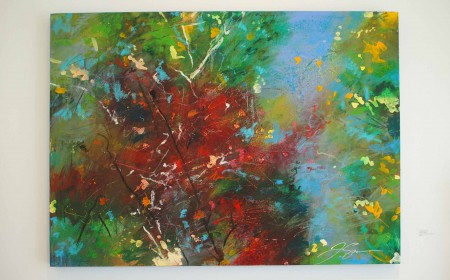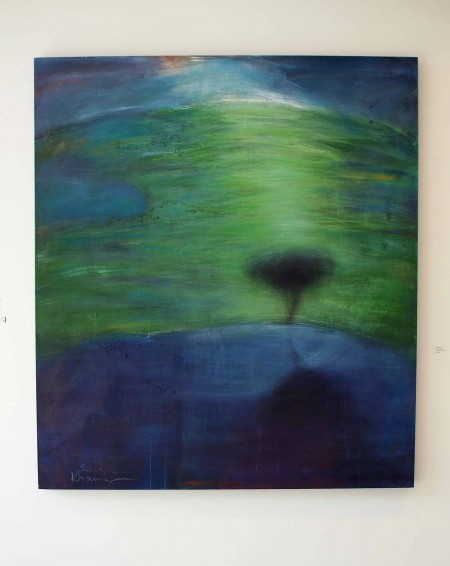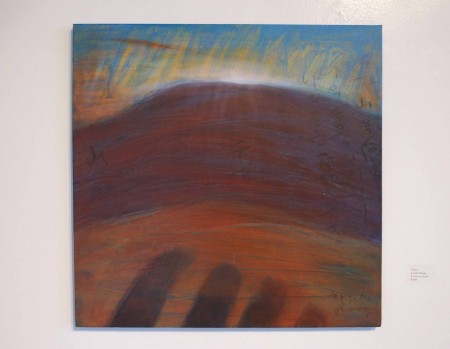Bridging Cultures, which will run at the C-Link Gallery at Brazee Street Studios through October 7, brings together the work of three Cincinnati artists, Eunshin Khang, Bukang Kim, and Frank Satogata. The exhibit explores their joint identities as Asian American painters. Western influenced work hangs in the main room of the gallery and Eastern influenced work is found in the second, smaller room. All three artists have work which lends itself to this separation, and moving from room to room opens the viewer’s eyes to differing artistic traditions. However, to my mind, the most compelling aspect of this exhibit is the dialogue it creates among these three mature, accomplished painters.
The exhibit includes work in calligraphy and the human figure, but the majority of the paintings are landscapes. Landscape painting is a way of seeing the external world. Great landscape painting can also evoke deep feeling and a sense of our place in the universe. Frank Satogata’s landscapes have a virile boldness. Of the three artists, he has the widest color palate. His paintings are full of vivid reds, yellows, and greens, their brightness emphasized by a sparing use of blues. He looks directly into the natural landscape from perspectives more appropriate to tiny animals or birds in flight than from that of humans. The world he sees has an inviting stillness. Two large landscapes employ the crossing lines and strong blotches of color characteristic of Abstract Expressionism. “Looking Skyward” looks upward through a canopy of trees; “Dappled Light” looks down on a pond surrounded by banks of green growth.
Although these works seem Western in style, we realize Satagota’s Japanese heritage informs them when we see “Tulip,” a landscape that overtly combines East and West. To a beautiful rendering of tulips about to bloom, seen from a vantage point that makes them seem as big as trees, he adds Japanese calligraphy and the signature seal of Asian art. In the upper left appears the word “Tulips,” making the painting bilingual. All three paintings express a Zen-like peace in the midst of the tension of Abstract Expressionism, Eastern serenity blended with Western aggression to produce a third state, which I would call simple joy in the beauty of the world.
Satagota has the most varied work in the exhibit. He offers series of flowers, abstracts, and calligraphy and a stunning dye sublimation print, “Chiheisen,” the title referring to the horizon seen from land. The most traditional Japanese subject, Mount Fujiyama, appears in one painting, and he adds a haiku to another, “Sunrise.” Satogata’s most arresting blending of East and West is “Zen Circle,” in which an Abstract Expressionist painting of three colored circles shares the canvas with Japanese calligraphy. In its boldness, simplicity and perfect balance, this work is a quintessential expression of the influences informing Satogata’s art.
In contrast to Frank Satogata, Korean-American painter Eunshin Khang offers flowing compositions, frequent use of blues and other cool colors, and a soft focus. Her abstract landscapes are emptied of all non-essential elements. Often her canvas is divided into three vertical bands: land, mountain, sky. “Not Alone #2,” a large landscape done almost entirely in blues and greens, has an earie beauty. A single tree on the horizon casts a shadow on the ground. The earth is blue and the sky, with its fading light, green. A thin crescent of light illuminates the tree below. With its elemental composition and luminous colors, the painting seems to glow from within. The work suggests serenity without being in any way sentimental. Eunshin Khang is a painter of inner light, which may be the most Eastern aspect of her work.
“Peaceful Mind,” another of Khang’s large landscape has a similar quality of illumination from within. Undulating hills lie beneath a sky that contains bright red and green objects, perhaps kites. “Peyto Lake Serenity,” an abstract rendering of an actual glacier lake in the Canadian Rockies, has a spare, dramatic composition of sky, mountains and water. The limited colors, mostly blue and black, contribute to the radical simplicity of the painting. As in most of Khang’s paintings, horizontal lines flow across the canvas with very little vertical interruption. Her work has none of the tension jutting lines give to Frank Satogata’s paintings. Khang’s most interesting Eastern painting is “Traces,” a small abstract landscape with very faint calligraphy. Near the top of the painting is a horizon, almost on fire with light. Shadows in the foreground near the bottom of the painting could be the fingers of the hand of the artist or viewer, bringing them into the painting. Reds rather than blues predominate. Again, there is inner light, but here it is warm and pulsing.
Khang’s most obviously Eastern works, “Cloud Story 2” and “Cloud Story 3.” resonate with Frank Satogata’s “Zen Circle.” Black circular shapes appear on a white background. A small dot of color, red in painting and gray in the other, draws the viewer’s eye. The paintings contain calligraphy and signature stamps. They are compelling in their simplicity and restrained use of color. Here a Zen harmony replaces the inner light of Khang’s other works.
Bukang Kim, also a Korean American artist, has had a distinguished career in Cincinnati for many years. The power of her paintings could overwhelm the exhibit if it did not interact so beautifully with the styles of the other two artists. Frank Satogata’s dense canvases express the pleasure he takes in flowers and trees. Eunshin Khang’s much emptier compositions have a harmonious glow. Bukang Kim’s dramatic landscapes depict the naked power of the natural world. Like the images of wind or ocean waves found in Asian woodblock prints, this power inspires awe but is not threatening. It just is, and must be respected. “Snow with Tree Trunk,” the most impressive painting in the exhibit, shows a wintry forest, the trunks of trees rising out of the snow, the jutting lines of their bare branches filling the upper half of the painting. There is bright, cold light in the pure white of the snow and forcefulness in the browns of the tangled trees. Kim fills every inch of the canvas, as Abstract Expressionism so frequently does, so the tension of the painting seems to extend beyond what the viewer can see. Although the setting could be found in the West, the use of minimal color and interlacing vertical lines, hinting at calligraphy, make the painting appear Eastern. In a similar fashion, “Tree Scape” uses appealing greens and earth tones, but the dramatic lines and abstract trees keep it from being anything like a pastoral Western landscape.
In “Morning Ocean,” a large seascape with dramatic use of color, Kim blends sea and sky into a single natural element. The painting is not peaceful, yet it does not convey any sense of danger. “Ocean Blue” has a similar effect. The deep colors of the painting, primarily blues, are stunning. There is light in the sky, but the water is in turmoil from a pending storm. All of Bukang Kim’s landscapes in the “Western” room of the exhibit are sufficiently abstract to prevent them from being identified as actual places. These depictions of land and water convey the essence of the natural world rather than particular places.
Bukang Kim is represented in the “Eastern” room of the exhibit by “Mountain,” a tumultuous landscape with a snowcapped mountain. There is minimal use of color—primarily black, gray, lavender, and white. Faint images of calligraphy appear below the mountain. The painting hangs opposite Frank Satogata’s “Fujiyama,” a nod by a Korean American painter to this iconic Japanese subject. Bukang Kim has the only figurative paintings in the exhibit, “Figure Scroll 1” and “Figure Scroll 2,” done in ink on rice paper. These black on white works are large verticals. The figures, in distorted, tense poses, are rendered so abstractly they suggest calligraphy. In her artistic vision, Bukang Kim seeks the essential force residing in her subjects. In these two figural works she shows how calligraphy and the human figure can become one essence.
By bringing these three Asian American artists together, Bridging Cultures offers us a wonderful opportunity to experience the cultural traditions behind their art as well as the unique vision each of them brings to their painting.
–Daniel A. Burr









